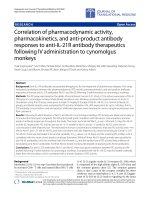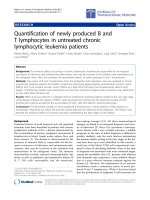Báo cáo hóa học: " Synthesis of Tapered CdS Nanobelts and CdSe Nanowires with Good Optical Property by Hydrogen-Assisted Thermal Evaporation" docx
Bạn đang xem bản rút gọn của tài liệu. Xem và tải ngay bản đầy đủ của tài liệu tại đây (334.89 KB, 5 trang )
NANO EXPRESS
Synthesis of Tapered CdS Nanobelts and CdSe Nanowires
with Good Optical Property by Hydrogen-Assisted Thermal
Evaporation
Min Wang Æ Guang Tao Fei
Received: 7 February 2009 / Accepted: 9 June 2009 / Published online: 10 July 2009
Ó to the authors 2009
Abstract The tapered CdS nanobelts and CdSe
nanowires were prepared by hydrogen-assisted thermal
evaporation method. Different supersaturation leads to two
different kinds of 1D nanostructures. The PL measure-
ments recorded from the as-prepared tapered CdS nano-
belts and CdSe nanowires show only a bandgap emission
with relatively narrow full-width half maximum, which
means that they possess good optical property. The as-
synthesized high-quality tapered CdS nanobelts and CdSe
nanowires may be excellent building blocks for photonic
devices.
Keywords Nanomaterials Á II-VI semiconductors Á
Chemical vapor deposition Á Vapor–liquid–solid Á
Photoluminescence
Introduction
One-dimensional (1D) nanostructures such as nanowires,
nanorods, nanobelts, and nanotubes have become the focus
of intensive research owing to their novel physical prop-
erties and applications in the fabrication of nanoscale
devices [1]. In particular, considerable efforts have been
made to synthesize 1D II-VI semiconductors and investi-
gate their electronic and optical properties because of their
wide applications in optoelectronic devices, such as lasers
[2, 3]. In order to achieve their full potential in optical
applications, it is essential to prepare 1D II-VI semicon-
ductors, which possess predominantly bandgap emission
without defect-related emission, namely good optical
property [4]. In principle, the optical property can vary
with the growth process, i.e., it is condition dependent and
process dependent [5]. For example, Barrellet et al. [6]
reported that CdS nanowires, synthesized by thermal
decomposition of the single-source molecular precursors
via the vapor–liquid–solid (VLS), possessed only a bandgap
emission. Defect-related emission (750 nm) appeared in the
PL spectra of CdS nanobelts and nanowires prepared by
direct reaction of Cd and S and thermal evaporation of CdS,
respectively [7, 8]. The photoluminescence (PL) spectrum
of 1D CdS nanostructures synthesized with solvothermal
route consisted of bandgap and defect-related emission
[5, 9–11]. This may be attributed to that the relatively bad
crystallinity is commonly achieved in solvothermal method
[12]. That is, it is still a challenge to develop synthetic
methods to prepare 1D II-VI semiconductors with high-
quality optical property.
In this paper, we utilize the hydrogen-assisted thermal
evaporation method, with which Jiang et al. [13] synthe-
sized ZnS nanoribbons on a large scale, to prepare CdS and
CdSe 1D nanostructures based on VLS process. The PL
measurements recorded from the as-synthesized tapered
CdS nanobelts and CdSe nanowires show only a bandgap
emission, which means they possess high-quality optical
property.
M. Wang Á G. T. Fei (&)
Key Laboratory of Materials Physics, Institute of Solid State
Physics, Hefei Institutes of Physical Science,
Chinese Academy of Sciences, P.O. Box 1129,
230031 Hefei, People’s Republic of China
e-mail:
M. Wang Á G. T. Fei
Anhui Key Laboratory of Nanomaterials and Nanostructures,
Institute of Solid State Physics, Hefei Institutes of Physical
Science, Chinese Academy of Sciences, P.O. Box 1129,
230031 Hefei, People’s Republic of China
123
Nanoscale Res Lett (2009) 4:1166–1170
DOI 10.1007/s11671-009-9376-9
Experimental Details
For the synthesis of tapered CdS nanobelts, CdS powders
(Strem Chemicals, 99.999%) placed in a ceramic boat was
put at the center of a quartz tube, which was inserted into a
horizontal tube furnace. The silicon wafer coated with
*2 nm Au film was perpendicularly placed on the other
ceramic boat located downstream, 10 cm away from the
source material. Prior to heating, high-purity Ar was
introduced into the quartz tube to purge the air inside for
60 min. After that, a carrier gas of high-purity Ar mixed
with 5% H
2
was kept flowing at a rate of 60 sccm (standard
cubic centimeter per minute). The furnace was heated to
800 ° C with a heating rate of 100 °C min
-1
and maintained
at this temperature for 40 min. Then, the furnace was
cooled down to room temperature slowly (*5 °C min
-1
).
CdSe nanowires were synthesized through the same proce-
dure by using CdSe powders (Strem Chemicals, 99.999%)
as source material and the source zone temperature of
650 ° C.
Samples collected from the silicon substrates were char-
acterized by a field-emission scanning electron microscopy
(FE-SEM, Sirion 200), high-resolution transmission electron
microscopy (HRTEM, JEOL-2010), and X-ray diffraction
(XRD, Philips X’pert PRO).
Photoluminescence (PL) measurements were conducted
at room temperature with a He–Cd laser using 325 nm and
514.5 nm as excitation source for CdS nanobelts and CdSe
nanowires, respectively.
Results and Discussion
Figure 1a shows a FE-SEM image of as-synthesized tapered
CdS nanobelts. These nanobelts have the thickness of 20–
40 nm, the base width of 2–5 lm, and the length of 10–
30 lm and possess triangle morphology. They have smooth
surfaces, and their width reduces sharply with the increase of
length. Figure 1b shows a FE-SEM image of the CdSe
nanowires. These nanowires have diameter of *100 nm and
length of 10–20 lm. Figure 1c, d shows the X-ray diffrac-
tion (XRD) patterns of CdS nanobelts and CdSe nanowires,
respectively. They are both of hexagonal wurtzite structure,
which correspond to respective bulk wurtzite CdS (JCPDS
77-2306) and CdSe (JCPDS 77-2307) crystals.
Microstructure analysis of the samples was carried out
with TEM. The Au particles were found atop the tapered
CdS nanobelts, as shown in Fig. 2a. The HRTEM image of
the CdS nanobelt was shown in Fig. 2b, and the lattice
spacings are about 0.68 nm and 0.36 nm, which agree with
the (0001) and (01–10) lattice planes of CdS, respectively.
The HRTEM image shows that the tapered CdS nanobelts
possess good crystallinity. From the TEM image of CdSe
nanowire in Fig. 3a, Au particle can be observed at the end
of the nanowire. In the HRTEM in Fig. 3b of the CdSe
nanowire, the lattice spacings are about 0.36 nm and
0.16 nm, which agree with the (0002) and (21–10) lattice
planes, respectively. The HRTEM image suggests that the
prepared CdSe nanowires have good crystallinity. The
good crystallinity of tapered CdS nanobelts and CdSe
nanowires may enable that they possess high-quality optical
property.
Similar to the work of Jiang et al. [13], the growth
process can be understood as following:
CdSðsolidÞþH
2
ðgasÞ H
2
SðgasÞþCdðgasÞ
CdSeðsolidÞþH
2
ðgasÞ H
2
SeðgasÞþCdðgasÞ:
In source zone with high temperature, the oxidation–
reduction reaction between CdS (CdSe) and H
2
forms H
2
S
(H
2
Se) gas and Cd gas, which are transported to deposition
zone with lower temperature where they react with
each other and form CdS (CdSe) and H
2
. After heating
for 40 min, CdS exhausts and most CdSe remains, which
means the reaction between CdS and H
2
is rapid while the
one between CdSe and H
2
is slow.
The presence of Au particle on the tip of CdS nanobelt
(Fig. 2a) and CdSe nanowire (Fig. 3a) illuminate that the
growth process includes VLS mechanism [14–20]. For the
formation of CdSe nanowires, CdSe vapor was deposited
onto liquid Au particles in the initial stage. When the dis-
solution of CdSe in the Au particles became supersaturated,
CdSe nanowires extruded from the liquid Au catalysts and
precipitated at the liquid–solid interface. In this process, a
liquid cluster of metal catalyst provides energetically
favored sites for the absorption of gas-phase reactants, and
sizes of the catalysts are considered to be responsible for the
resultant diameters of nanowires. In our experiment, the low
supersaturation due to the slow reaction between CdSe and
H
2
favors the 1D nucleation [21, 22], and the CdSe nano-
wire growth proceeds by VLS mechanism. While the rapid
reaction between CdS and H
2
produces very large vapor
pressure of CdS gas in source zone and high supersaturation
in deposition zone, which makes for 2-dimensional nucle-
ation [21, 22]. Besides the metal catalyst, the side surface of
the CdS nanobelts formed previously may become the
preferred nucleation site for CdS growth. So the CdS
nanobelt growth proceeds by VLS mechanism in axial
direction and vapor–solid mechanism in lateral direction,
which is similar to the prior reports [23–25]. As a result, the
nanobelt’s width increases gradually along the axial direc-
tion starting from the contact region between liquid Au
nanoparticle and CdS, i.e., the tapered CdS nanobelts form.
Nanoscale Res Lett (2009) 4:1166–1170 1167
123
Fig. 1 SEM images of tapered
CdS nanobelts (a) and CdSe
nanowires (b), respectively.
XRD patterns of tapered CdS
nanobelts (c) and CdSe
nanowires (d), respectively
Fig. 2 TEM (a) and HRTEM
(b) image of a single tapered
CdS nanobelt
Fig. 3 TEM (a) and HRTEM
(b) image of a single CdSe
nanowire
1168 Nanoscale Res Lett (2009) 4:1166–1170
123
The optical properties of tapered CdS nanobelts and
CdSe nanowires were studied by PL at room temperature.
Figure 4a, b shows the PL spectra of CdS nanobelts and
CdSe nanowires, recorded with 325 nm and 514.5 nm
excitation, respectively. The spectrum of CdS nanobelts
shows only a single peak centered at 510 nm with narrow
full-width half maximum (fwhm) of 20 nm. The peak can
be attributed to the band gap emission, because the peak
position is very near the band gap of CdS (2.47 eV) at
room temperature [26, 27]. The relatively narrow fwhm
and absence of defect-related emission demonstrate that the
tapered CdS nanobelts, synthesized by hydrogen-assisted
thermal evaporation in this work, possess high-quality
optical property. Wang et al. [8] reported that only a
defect-related emission (750 nm) could be observed in
PL spectrum of CdS nanowires, synthesized by thermal
evaporation of CdS powders based on VLS mechanism. In
previous works [28, 29], the defect-related emission was
considered to originate from the sulfur vacancies V
s
?
.
Without hydrogen, sulfur in CdS may be oxidized by the
residual oxygen in the furnace [30, 31], and consequently
many V
s
?
exist in the CdS samples, which results in the
defect-related emission. While in the reductive ambience
with the addition of hydrogen, sulfur in CdS may be pre-
vented to oxidize, and V
s
?
in the CdS samples may decrease
and even disappear. Therefore, we think that the addition of
hydrogen should be critical to obtain the excellent optical
property of taped CdS nanobelts in this work. In Fig. 4b,
the spectrum of CdSe nanowires shows a single peak
centered at 717 nm with fwhm of 31 nm, which is attrib-
uted to the band gap emission (1.74 eV at room tempera-
ture). The tapered CdS nanobelts and CdSe nanowires with
high-quality optical property should be good building
blocks for photonic devices.
Conclusions
In summary, tapered CdS nanobelts and CdSe nanowires
were prepared by hydrogen-assisted thermal evaporation
method. Tapered CdS nanobelt growth process includes
VLS mechanism in axial direction and vapor–solid mech-
anism in lateral direction under high supersaturation. CdSe
nanowires growth proceeds by VLS mechanism under low
supersaturation. The PL measurements recorded from the
as-prepared CdS and CdSe 1D nanostructures show only a
bandgap emission with relatively narrow fwhm, which
means they possess high-quality optical property. The as-
synthesized high-quality tapered CdS nanobelts and CdSe
nanowires may be good building blocks for photonic
devices.
Acknowledgments This work was supported by the National Natural
Science Foundation of China (No.50671099, 50172048, 10374090, and
10274085), Ministry of Science and Technology of China (No.2005
CB623603), and Hundred Talent Program of Chinese Academy of
Sciences.
References
1. J. Hu, T.W. Odom, C.M. Lieber, Acc. Chem. Res. 32, 435 (1999)
2. X.F. Duan, Y. Huang, R. Agarwal, C.M. Liber, Nature 421, 241
(2003)
3. M.H. Huang, S. Mao, H. Feick, H.Q. Yan, Y.Y. Wu, H. Kind,
E. Weber, R. Russo, P.D. Yang, Science 292, 1897 (2001)
4. U. Philipose, T. Xu, S. Yang, P. Sun, H.E. Ruda, J. Appl. Phys.
100, 084316 (2006)
5. Y.C. Li, X.H. Li, C.H. Yang, Y.F. Li, J. Mater. Chem. 13, 2641
(2003)
6. C.J. Barrelet, Y. Wu, D.C. Bell, C.M. Liber, J. Am. Chem. Soc.
125, 11498 (2003)
Fig. 4 PL spectra of tapered CdS nanobelts (a) and CdSe nanowires
(b), respectively. PL measurements were conducted at room temper-
ature with a He–Cd laser using 325 nm and 514.5 nm as excitation
source for CdS nanobelts and CdSe nanowires, respectively
Nanoscale Res Lett (2009) 4:1166–1170 1169
123
7. Z.Q. Wang, J.F. Gong, J.H. Duan, H.B. Huang, S.G. Yang, X.N.
Zhao, R. Zhang, Y.W. Du, Appl. Phys. Lett. 89, 033102 (2006)
8. Y.W. Wang, G.W. Meng, L.D. Zhang, C.H. Liang, J. Zhang,
Chem. Mater. 14, 1773 (2002)
9. L. Zeiri, I. Patla, S. Acharya, Y. Golan, S. Efrima, J. Phys. Chem.
C 111, 11843 (2007)
10. A.L. Pan, X. Lin, R.B. Liu, C.R. Li, X.B. He, H.J. Gao, B.S. Zou,
Nanotechnology 16, 2402 (2005)
11. D. Xu, Z.P. Liu, J.B. Liang, Y.T. Qian, J. Phys. Chem. B 109,
14344 (2005)
12. Y.J. Hsu, S.Y. lU, Langmuir 20, 23 (2004)
13. Y. Jiang, X.M. Meng, J. Liu, Z.Y. Xie, C.S. Lee, S.T. Lee, Adv.
Mater. 15, 323 (2003)
14. R.S. Wagner, W.C. Ellis, Appl. Phys. Lett. 4, 89 (1964)
15. G.A. Bootsma, H.J. Gassen, J. Cryst. Growth 10, 223 (1971)
16. J.P. Ge, J. Wang, H.X. Zhang, Y.D. Li, Chem. Eur. J. 10, 3525
(2004)
17. A.M. Morales, C.M. Liber, Science 279, 208 (1998)
18. Y.Y. Wu, P.D. Yang, J. Am. Chem. Soc. 123, 3165 (2001)
19. M.S. Gudiksen, C.M. Lieber, J. Am. Chem. Soc. 122, 8801
(2000)
20. C.J. Barrelet, Y. Wu, D.C. Bell, C.M. Lieber, J. Am. Chem. Soc.
125, 11498 (2003)
21. X.S. Fang, C.H. Ye, L.D. Zhang, Y.H. Wang, Y.C. Wu, Adv.
Funct. Mater. 15, 63 (2005)
22. C.H. Ye, X.S. Fang, Y.F. Hao, X.M. Teng, L.D. Zhang, J. Phys.
Chem. B 109, 19758 (2005)
23. Y. Wang, G.Z. Wang, M.Y. Yau, C.Y. To, D.H.L. Ng, Chem.
Phys. Lett. 407, 510 (2005)
24. R. Venugopal, P.I. Lin, C.C. Liu, Y.T. Chen, J. Am. Chem. Soc.
127, 11262 (2005)
25. S. Kar, S. Chaudhuri, J. Phys. Chem. B 110, 4542 (2006)
26. S.Y. Lu, M.L. Wu, H.L. Chen, J. Appl. Phys. 93, 5789 (2003)
27. A.L. Pan, J.G. Ma, X.Z. Yan, B.S. Zou, J. Phys.: Condens. Mater.
16, 3229 (2004)
28. A.A. Vuyesteke, Y.T. Sihvonen, Phys. Rev. 113, 40 (1959)
29. W.F. Liu, C. Jia, C.G. Jin, L.Z. Yao, W.L. Cai, X.G. Li, J. Cryst.
Growth 269, 304 (2004)
30. M. Wang, G.T. Fei, Y.G. Zhang, M.G. Kong, L.D. Zhang, Adv.
Mater. 19, 4491 (2007)
31. M. Wang, G.T. Fei, X.G. Zhu, B. Wu, L.D. Zhang, J. Phys.
Chem. C 113, 8730 (2009)
1170 Nanoscale Res Lett (2009) 4:1166–1170
123









